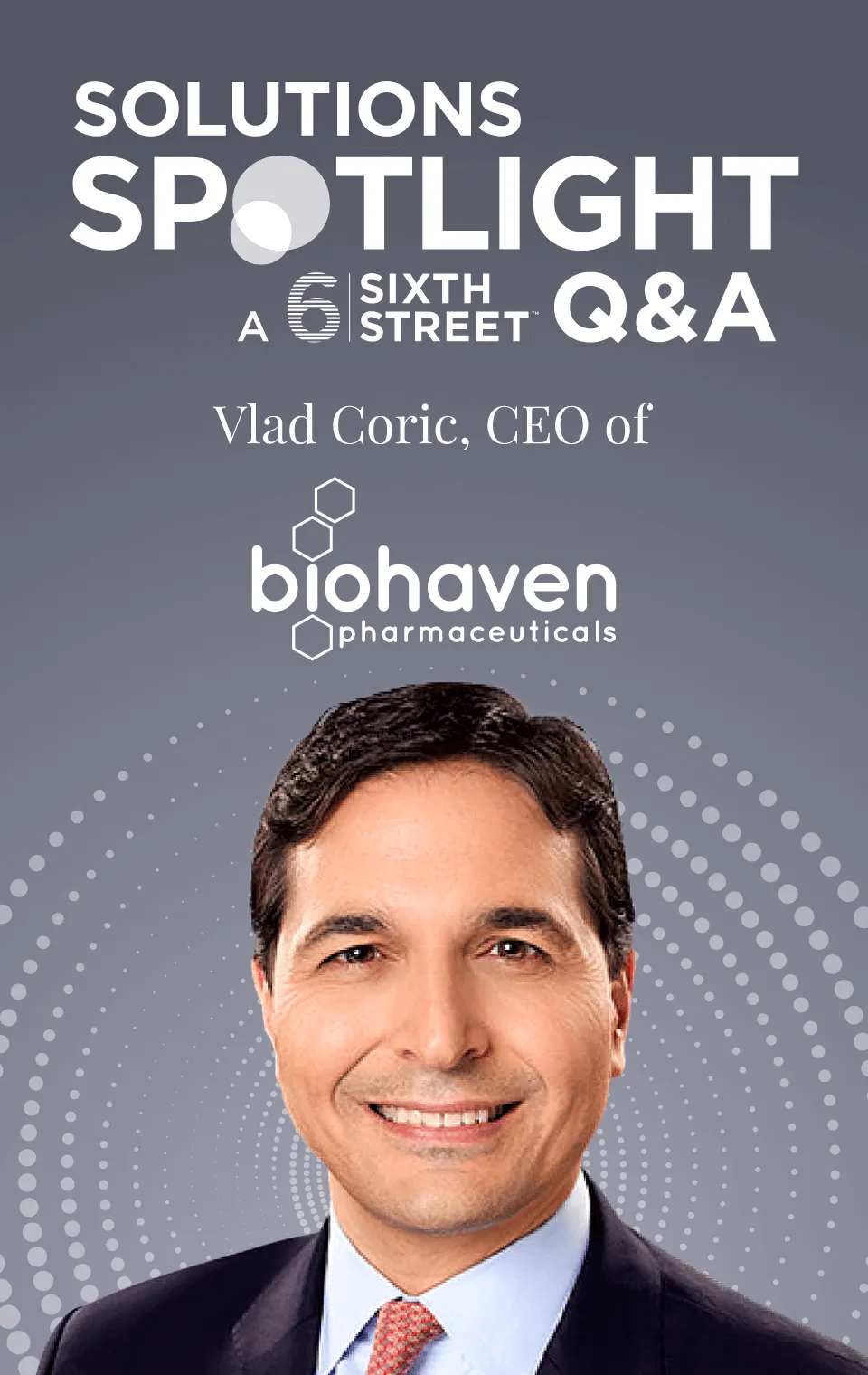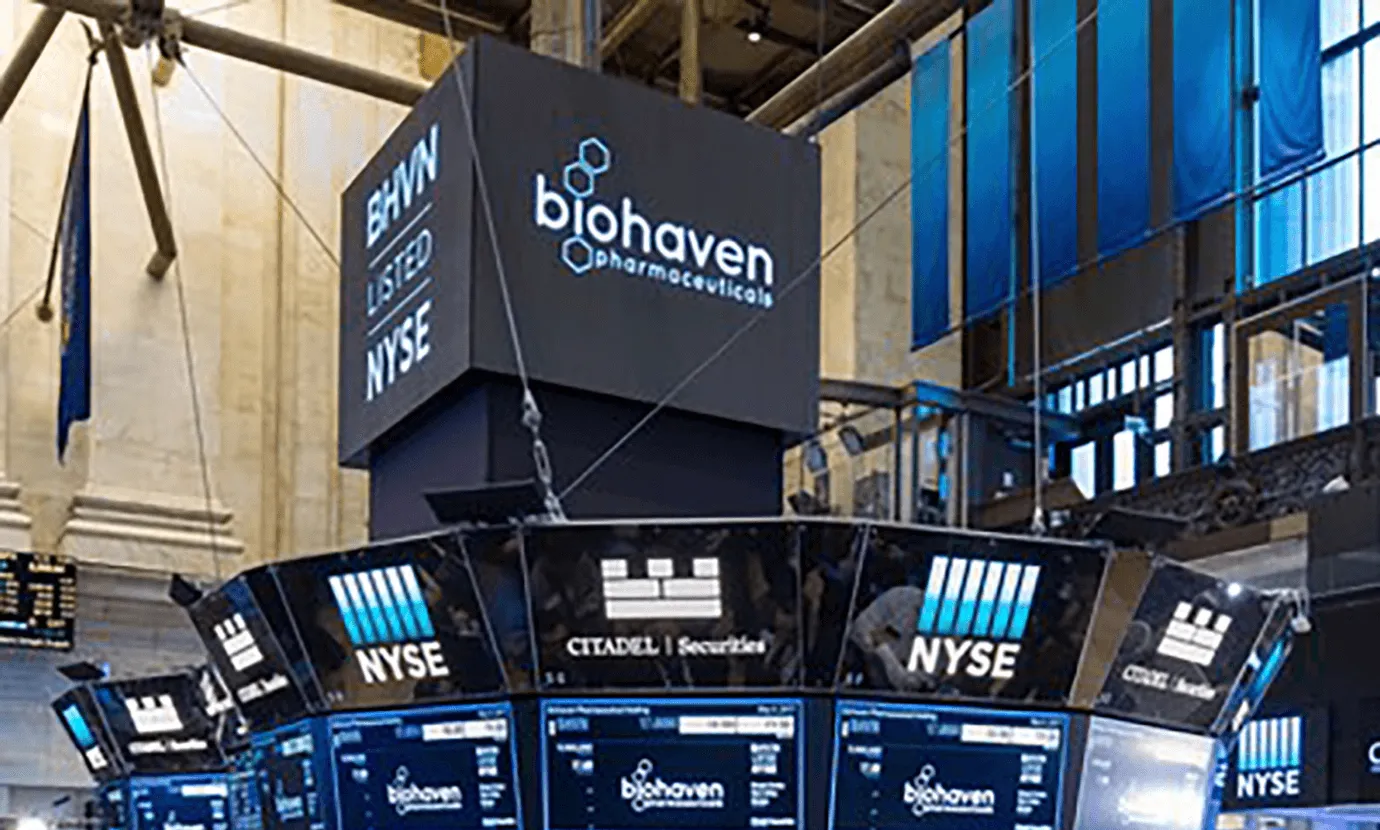
We sat down with Vlad Coric, CEO of Biohaven, for a behind-the-scenes look at how Sixth Street’s solutions helped bring a novel therapy to migraine patients and what’s next for the company after its acquisition by Pfizer.
Biohaven (NYSE: BHVN) is a commercial-stage biopharmaceutical company with a portfolio of late-stage product candidates targeting neurological and neuropsychiatric diseases, including rare disorders. The company is best known for Nurtec® ODT (rimegepant 75 mg), which received FDA approval in February 2020 as the first orally disintegrating CGRP antagonist for the acute treatment of migraine.
Biohaven’s relationship with Sixth Street dates to early 2020, when the company began seeking capital to finance the commercialization of Nurtec® ODT following FDA approval.
Sixth Street provided Biohaven, a publicly listed company, with $500 million in non-dilutive financing as it brought Nurtec® ODT to market against incumbent big pharma migraine treatments. Sixth Street would later upsize the financing to a total of $750 million.
In May 2022, Biohaven announced that Pfizer was acquiring the company for $11.6 billion. The transaction subsequently closed in October of 2022.
In this conversation, Sixth Street’s Healthcare and Life Sciences team talks with Vlad Coric, MD about the firm’s capital strategy, the broader biotech market, and what’s next for the company with Pfizer.
Learn more about Sixth Street Healthcare and Life Sciences
Q&A
Sixth Street: Vlad, thanks for doing this and congratulations on the Pfizer acquisition.
Take us back to your original decision to license rimegepant out of BMS. What were your expectations for the product and the market opportunity, and then what actually happened? What’d you get wrong? And that can be both good and bad.
Vlad Coric: When we go back to the decision to license Nurtec® ODT, you have to appreciate what was going on in the greater pharma field at the time. Most of pharma was focused on immuno-oncology. Many companies had decided that they were going to exit neuroscience, which created a unique opportunity for us at Biohaven because these are some of the worst disorders that face society, yet our largest companies were leaving the area.
We viewed that as a big opportunity, and that’s really what got us to focus on in-license strategies, including Nurtec® ODT. We believed Nurtec® ODT was going to be a product that not only had more efficacy, but really it changed the paradigm on the safety front.
When you look at the older triptans that are used here, they’re plagued with side effects. Migraine patients want their migraines to go away and don’t want new problems. And that’s a profile we saw in Nurtec® ODT.
We are very data-driven, and so we said, ‘Let’s run the study and have the data determine what’s right or wrong’. It’s a little bit more humbling than to think you have the right answer.
For example, we followed this approach when formulating the oral dissolving tablet. We had this notion that we’d be able to beat our competitors with a differentiated approach by having an ODT that would dissolve quickly, something migraine patients would prefer.
We ran a head-to-head trial, one trial with a tablet, one trial with our quick dissolve, and let the data determine the right path forward. It was a little more expensive than what most small companies would consider pursuing, doing two parallel studies like that, but we thought it would help us get the best answer in the best differentiation.
The quick dissolve worked an hour earlier. Patients who were nauseated with migraines didn’t need to swallow liquids or take food with it. It ended up being a very important differentiator. During the rest of the program, we nailed it on the efficacy compared to our competitors because of the quick dissolve. In addition to that, the safety profile was what we expected, helping us exceed our highest expectations for the target product profile.
Sixth Street: Nurtec® ODT was approved and launched three months after Ubrelvy, which was marketed by AbbVie, a giant in the pharma world. What made you think that Biohaven could go head-to-head against a competitor that has effectively unlimited funding?
Vlad Coric: It was a David versus Goliath story. We realized they had a lot more resources and a lot more people than we did. We had to be quicker and smarter.
“It was a David versus Goliath story…”
We had the opportunity to immerse ourselves in Nurtec® ODT every single day and focus on that versus our larger competitor who had a lot of other assets that they were delivering to patients. We had this advantage of having this tunnel vision on the CGRP space and an ability to out-maneuver our competitors. That’s really what I mean by smarter. We immersed ourselves in it and come up with a better differentiation plan.
We also had to be quicker. When we picked up Nurtec® ODT from BMS, AbbVie had an 18-month lead on us. Most people and investors at the time were telling us, “You’re going to be way too late and you’re not going to be able to overcome the almost two-year launch lead.”
The first thing we had to do to set the stage to compete with AbbVie was reach the market around the same time.To do things in an accelerated fashion, you need more resources. We decreased the lead by running our trials in about half the time that AbbVie ran theirs. We decreased our leads from 18 months to nine months. For the final part of the strategy, we bought a priority review voucher for $120 million or so, providing us with six-month’s worth of savings.
Sixth Street: And then can you tell us about the launch process itself, and the patient-first and digital-first approach you took?
Vlad Coric: If it wasn’t for bringing the lead down from 18 months to three months, it would’ve been difficult to compete in the launch. Getting to the starting line around the same time as AbbVie launched was key. AbbVie was a much larger company. We could not take the old conservative strategy if we’re going to match up our drug reps with theirs.
We also had to be nimbler and more innovative. We said, “Okay, we have to modernize a launch”. We had to take a bold step by moving forward with a smart digital-first strategy. A true digital-first, not what most companies do where they have a traditional large sales force launch, and they augment it with digital. We had to innovate. We had to team up with digital partners, with online pharmacies, with telehealth platforms, and then push out patient testimonials in a very different and personal way so that people would understand the value proposition of Nurtec® ODT.

One of the ways we did it was by teaming up with Khloé Kardashian. A longtime migraine sufferer who responded quite robustly to Nurtec® ODT. She became a very important spokesperson for us in this digital first strategy. She had over 125 million social media followers when she first tweeted about her experience with Nurtec® ODT, resulting in hits on our website and remarkable copay card downloads.
Going directly to patients with the value proposition proved to be very important. We developed a whole social media pyramid of influencers. Starting with the really mega-influencers like Khloé but then going all the way down to micro- and nano-influencers of people with migraine stories. That was the most important aspect of our launch and allowed us to outmaneuver a much larger company that was using traditional launch tactics. The patient-first mantra and digital first launch was what made us successful.

Sixth Street: That’s great. I’m curious how you applied real-world data and other novel data techniques in your launch and how that helped accelerate everything.
Vlad Coric: When you look at pharma companies, they traditionally spend all their innovation and risk brainstorming in the R&D portion. When they get to the launch, they get very conservative. They revert to outdated tactics. The industry has been very slow to integrate real-time information on what’s going on at a patient level and at physician level.
To make the launch efficient, we created an internal dashboard that had every piece of data we could get our hands on, regarding how different tactics were able to be effectively communicated to patients. By doing that, we were able to conduct some sophisticated analyses to better direct our resources and enhance our sales – everything from understanding access with different insurance companies to understanding patterns of prescriptions helped us outmaneuver the competitor.
Sixth Street: You were masterful in your use of creative capital raises to fund Biohaven with well over a billion dollars of non-dilutive capital ranging from pre-approval royalties, preferred equity deals to the critical use of non-dilutive debt capital that we, Sixth Street, funded. As a public company CEO about to launch a drug into a massive market, what were your financing needs and what were your options that you were considering?
Vlad Coric: The biggest thing when you’re going up against a large competitor like AbbVie is you have to be fully funded for unanticipated needs and need to be able to pivot because not everything you do is going to work in your launch.
We talked about the digital first strategy. Not every component of that is going to be effective. There’s going to be some inefficiencies, and as you learn, you need additional capital to make sure that you can continue to try and outmaneuver your competitors.
The key to our financial needs was making sure we had the right partners that could be with us as we saw returns on our investment and revenue from Nurtec® ODT coming in, so they could work with us like Sixth Street did to give us additional capital to fund the launch. The last thing you want to do is stall in the financing front at the most critical time when you’re trying to beat your competitor in the field.
Sixth Street: It sounds like a capital partner, who can scale with you over time was important. Why did you choose the non-dilutive path, and why was the financing Sixth Street provided so attractive to you?
Vlad Coric: Every time we do a financing, we take it very seriously. We don’t reflexively go back to the equity capital markets, which is what a lot of smaller companies do. For them, it’s the path of least resistance. When you look at success of equity market raises, there is a dilution factor that over time can really erode the value of the company.
It was key for us to augment our financing with different paths and the most important one was the Sixth Street financing. We also conducted other financings with royalty purchases, but what we found attractive about Sixth Street was when you looked at the cost of capital, it was the lowest cost that was available to us at the time, versus equity, and further royalty’s sales would have been much more dilutive for us as a company.
Critically, Sixth Street had the bandwidth, as our sales increased, to give us access to additional capital that was also at an attractive rate. It was critical for us at this stage of the Company and our launch would not have been as successful unless we had access to that type of capital. We were able to utilize that in a very responsible way and grow our sales prior to our sale to Pfizer. We have a run rate of close to a billion dollars of net revenue thanks to the financing that we received from Sixth Street.
Sixth Street had the bandwidth, as our sales increased, to give us access to additional capital. It was critical for us at the launch phase. Our launch would not have been successful unless we had access to that type of capital… We are at a run rate of close to a billion dollars of net revenue thanks to the financing that we received from Sixth Street.
Sixth Street: Hindsight is always 2020, but would you have made any different decisions looking back?
Vlad Coric: I’m not one who likes to look in the rear view mirror a lot. At the time that you’re making the decisions, you have to make your best strategic path forward at the time. Looking back, I think we had a good balance between different types of financing to create value for our investors. I would’ve liked to have launched three months prior to AbbVie and not during a pandemic!
But as entrepreneurs, challenges come up, and you have to always be focused on finding a path of success around those challenges and remaining optimistic that you’ll be successful with the right team behind you. I think we made a lot of hard decisions. Not all of them were the right ones, but most were, and our team attained success by working through some difficult times.
Sixth Street: Drug launches are hard, and they usually don’t go to plan. Not only did you execute and beat expectations, but you did it during the pandemic. This is a pure pandemic launch. It really speaks to the quality of the product, strength of the management team, and your approach to taking a differentiated attack plan.
…as entrepreneurs, challenges come up, you have to always be focused on finding a path of success around those challenges and remaining optimistic that you’ll be successful with the right team behind you
Vlad Coric: You're right. Many companies work 10 years to get a drug approved. The week of our approval, a global lockdown hits – talk about difficult decisions. There was a lot of pressure not to launch, to delay things for a year. Some even suggested laying off the sales force and not proceeding, waiting until the end of the pandemic. That all would've been really devastating for our company if we had followed any of that. Instead, we said, ‘Look, despite those challenges, we are going to find a path forward’. And we did that. Thanks to partners like yourselves and others, we had the right funding. People with migraine needed access to Nurtec® ODT because as stress and worries about the pandemic increased, people's migraines got worse. It was an even more important time to launch, and we took that seriously. We're in the healthcare industry and it comes back to being patient-first. Thankfully, we were quite successful.
Sixth Street: Pfizer acquired Nurtec® ODT and the related CGRP assets for over $11.6 billion. What do you think were the key drivers of Pfizer's decision here?
Vlad Coric: From the early days that we began to interact with Pfizer, what struck me was the shared cultural values that we both had. We wanted to create medicines that make a real difference for patients. For both payer and patient reasons, you need to have drugs that are real paradigm shifts, and that's what you saw in Nurtec® ODT.
When you looked at the ability for us to get a label for both the acute and prevention of migraine in one drug, that had never been done before in the migraine space. When you looked at the quick onset of action of the quick-dissolving Nurtec® ODT, those aspects of the drug and how we developed it, catapulted us into being the number one prescribed migraine therapy.
I think that was key to Pfizer's decision. They appreciated that this was going to change the way migraines were treated across the world. This was going to provide transformational value for patients. We had this shared belief about following the science, making a big difference for patients, changing the paradigm and that was the key driver to the deal with Pfizer ultimately.
Sixth Street: Most CEOs who’ve accomplished what you did with Biohaven and a Nurtec® ODT would have been happy to ride off into the sunset. You aren’t. Tell us about what’s next for you and the team?
…we have this shared vision we’re here to help folks and to try to advance therapies in neuroscience. And this team is excited as ever to do it.
Vlad Coric: There are too many patients left to help to ride off into the sunset. You have an obligation when you put a team together like this to try to do it again. Of course, we want to be successful, but it's a tough space in neuroscience. We closed the Pfizer deal on October 3rd and on October 4th, we launched our new company. Our team did not miss a beat. There are many people on our team who could have retired but we have this shared vision. We're here to help folks and to try to advance therapies in neuroscience. This team is excited as ever to do it.
We’re already fast at work. We have 13 programs and we’re already advancing into our later stage products. We don’t think it’ll be long before you start hearing about the next paradigm shift from Biohaven. We really have an amazing team, a broad portfolio, and are well-positioned with access to capital to be able to do this again. We’re looking forward to working with partners like Sixth Street and others, to try and repeat what we did with Nurtec® ODT for patients with other neurologic disorders.
Sixth Street: Speaking for the Sixth Street team, it really was an honor to work with you and the entire Biohaven team to be a part of such an incredible success story. This has been a highlight for us to help bring a drug to market that is helping millions of patients. This has had a dramatic impact in the lives of so many people. It was an honor and a privilege to work with you, and we are excited for the next chapter and hope to be a part of it.
Vlad Coric: Thanks to the Sixth Street team and we are really looking forward to it.
